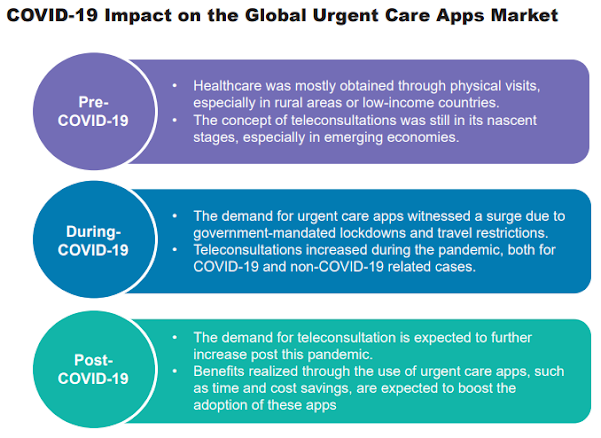Urgent care apps are intended to serve patients seeking urgent care by connecting them to a relevant specialist and facilitating further courses of action such as diagnosis, treatment, and monitoring.
Treatment can be offered remotely via text/audio/video calls, or help can be arranged to usher the patient to the nearest hospital. The widespread adoption of smartphones and increased demand for urgent and convenient access to care will be crucial to the market’s growth.
The global urgent care apps market was valued at $973.6 million in 2020 and is anticipated to grow to $10,150.5 million by the end of 2030 at a projected CAGR of 26.32% during the forecast period 2021-2030.
The aforementioned growth is based on the realistic forecast, which is the most likely growth scenario based on current market conditions. This scenario assumes that there will be no visible impact of COVID-19 beyond 2030. The changes in the market during that timeline can build upon the developments of this decade.
The COVID-19 pandemic has positively impacted the global urgent care apps market due to factors such as shift in preference from at-clinic to at-home virtual care, technological advancements in healthcare, and improving internet connectivity.
What is the addressable market size and forecast based on region?
The North America region has one of the most technologically advanced healthcare systems globally. The various factors propelling the growth of the regional market include increasing smartphone adoption and the presence of established as well as emerging players in the market.
In Europe, evolving regulatory landscape and the government’s measures to bolster data privacy are the primary reasons contributing to the growth of the regional market.
The emergence of 5G technology is one of the major factors driving the growth of the urgent care apps market in Asia-Pacific.
What are the key trends of the global urgent care apps market?
The key technological trends anticipated to have maximum influence on the global urgent care apps market during the forecast period 2021-2030 include artificial intelligence for personalized care, shift from physical care to telemedicine, remote patient monitoring ecosystems, increasing smartphone penetration, and focus on the entire patient journey beyond diagnosis.
In the short term, i.e., during 2021-2025, the key trends anticipated to impact the global urgent care apps market include the ongoing shift from physical care to telemedicine and remote patient monitoring. This is due to factors such as technological advancements in cellular communications, such as the growth of 4G and 5G and government initiatives to promote telemedicine. The growth is anticipated to be considered in growing economies such as China, India, Brazil, and Mexico.
In the long term, i.e., during 2025-2030, the key trend expected to disrupt the global urgent care apps market is the shift toward telemedicine. The integration of AI in healthcare is anticipated due to the rising awareness about the technology, its potential to streamline healthcare processes and enable physicians to make better decisions.

BIS healthcare vertical offers intelligence in the healthcare technology market for precision medicine, robotics and imaging, life sciences and biopharma, medical devices, digital health, and other emerging healthcare technologies, covering the entire industry spectrum. In the past eight years, BIS Healthcare has published more than 50 reports under the precision medicine banner. Additionally, BIS Research has been nominating ‘Top 25 Voices’ in precision medicine on its InsightMonk platform for the past two years successfully.




Comments
Post a Comment